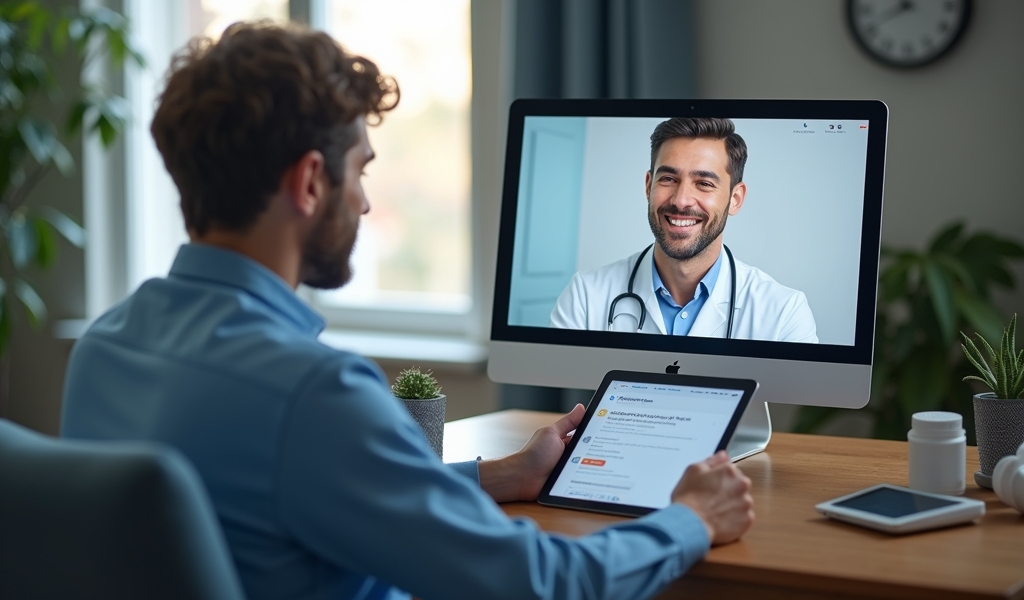Overview
Virtual MD visits offer five essential benefits: unparalleled convenience and accessibility, cost-effectiveness, reduced exposure to illness, enhanced continuity of care, and improved access to mental health services. These telehealth consultations connect patients with healthcare providers through secure digital platforms, allowing for effective treatment of many non-emergency conditions while eliminating traditional barriers to care such as travel time, waiting rooms, and geographic limitations.
Table of Contents
- Understanding Virtual MD Visits: What They Are and How They Work
- Benefit #1: Unparalleled Convenience and Accessibility
- Benefit #2: Cost-Effectiveness and Savings
- Benefit #3: Reduced Exposure to Illness
- Benefit #4: Enhanced Continuity of Care
- Benefit #5: Improved Access to Mental Health Services
- Getting Started with Your First Virtual MD Visit
- Conclusion
- Frequently Asked Questions
In today’s fast-paced world, healthcare is evolving rapidly to meet patient needs. A virtual MD visit represents one of the most significant advancements in modern healthcare delivery, transforming how patients connect with medical professionals. This innovative approach to medicine has gained tremendous popularity, especially since the COVID-19 pandemic highlighted the need for flexible healthcare options.
Virtual doctor appointments combine cutting-edge technology with traditional medical expertise to deliver care remotely. Whether you’re dealing with a minor illness, need a prescription refill, or require follow-up care, online doctor visits offer a convenient alternative to in-person appointments.
In this comprehensive guide, we’ll explore the five essential benefits of virtual doctor consultations and why they’ve become an integral part of contemporary healthcare. Let’s dive into how this technology is revolutionizing patient care while maintaining clinical excellence.
Understanding Virtual MD Visits: What They Are and How They Work
A virtual MD visit, also known as telemedicine or telehealth, involves consulting with a healthcare provider through digital communication technologies. These consultations typically occur via secure video conferencing platforms, though they may sometimes take place through phone calls or secure messaging systems.
The process is surprisingly straightforward. Patients schedule appointments through their healthcare provider’s online portal or a dedicated telemedicine application. When appointment time arrives, they log in to the platform, complete any preliminary information, and enter a virtual waiting room. The doctor then initiates the video call to begin the consultation.
During a virtual MD visit, doctors can perform many of the same evaluations they would during in-person visits. They can:
- Assess visible symptoms
- Discuss medical history and current concerns
- Prescribe or adjust medications
- Order laboratory tests or imaging
- Provide follow-up care instructions
- Make referrals to specialists when necessary
According to the American Medical Association, telehealth adoption has increased dramatically, with over 85% of physicians now using some form of virtual care. This mainstream acceptance reflects both provider confidence and patient satisfaction with the quality of care delivered through digital platforms.
Now that we understand what virtual MD visits entail, let’s explore their most compelling benefits.

Benefit #1: Unparalleled Convenience and Accessibility
Perhaps the most immediate advantage of a virtual MD visit is the remarkable convenience it offers. Traditional doctor appointments often require significant time commitments—driving to the office, finding parking, waiting in reception areas, and then reversing the entire process after seeing the doctor. In contrast, virtual visits eliminate these logistical challenges entirely.
With online doctor visits, patients can consult with physicians from virtually anywhere: their homes, offices, or even while traveling. This accessibility is particularly valuable for several groups:
- People with mobility limitations or disabilities
- Parents who would otherwise need childcare arrangements
- Individuals with demanding work schedules
- Rural residents who live far from medical facilities
- Elderly patients who face transportation challenges
Moreover, virtual MD visits often feature shorter wait times than traditional appointments. Many telehealth platforms offer same-day or next-day availability, dramatically reducing the typical weeks-long wait for in-person consultations. This improvement in access can be life-changing for those dealing with time-sensitive but non-emergency medical issues.
The convenience factor extends to prescription management as well. During a virtual visit, doctors can send prescriptions electronically to your preferred pharmacy, eliminating additional trips to medical offices for routine medication refills. Furthermore, many telehealth platforms integrate with pharmacy delivery services, creating a truly streamlined healthcare experience.
Research from the National Institutes of Health confirms that convenience and accessibility rank among patients’ top reasons for choosing telehealth services, with satisfaction rates consistently above 90% for these aspects of care.
Benefit #2: Cost-Effectiveness and Savings
Virtual MD visits typically cost significantly less than in-person appointments, creating financial benefits for both patients and the healthcare system. The average virtual visit costs between $40 and $80, compared to $100-$200 for traditional office visits, representing substantial savings of up to 60%.
This cost difference stems from several factors. Healthcare providers maintain lower overhead costs for telehealth services since they require less physical infrastructure. These savings are often passed along to patients in the form of reduced visit fees.
Beyond the direct cost of the appointment, virtual MD visits eliminate numerous indirect expenses:
- Transportation costs (fuel, public transit fares, parking fees)
- Lost wages from taking time off work
- Childcare expenses during appointments
- Meal costs while away from home
For patients managing chronic conditions that require frequent monitoring, these accumulated savings can be substantial over time. Additionally, the convenience of virtual care makes patients more likely to attend follow-up appointments and adhere to treatment plans, potentially preventing costly complications or hospitalizations.
Insurance coverage for telehealth has expanded dramatically in recent years. Most major insurance providers now cover virtual MD visits similar to in-person care, though co-pays and coverage details vary by plan. Medicare and Medicaid have also broadened their telehealth coverage, making these services accessible to more vulnerable populations.
From an employer perspective, offering telehealth benefits can reduce absenteeism and healthcare costs. Workers can address health concerns without taking entire days off, and early intervention through convenient virtual care helps prevent more serious and expensive health issues.
Benefit #3: Reduced Exposure to Illness
One of the most significant advantages of virtual MD visits became abundantly clear during the COVID-19 pandemic: the ability to receive medical care without risking exposure to contagious illnesses. This benefit extends well beyond pandemic concerns to everyday healthcare scenarios.
Traditional medical waiting rooms unintentionally bring together people with various illnesses in close proximity. For immunocompromised patients, pregnant women, elderly individuals, and those with chronic conditions, even routine exposure to common viruses can pose serious health risks. Virtual appointments eliminate this concern entirely.
The protection works both ways. If you’re experiencing symptoms of a contagious illness, a virtual MD visit allows you to receive proper medical attention without potentially exposing healthcare workers and other patients. This consideration becomes especially important during seasonal flu outbreaks or other infectious disease spikes.
Healthcare facilities have recognized this benefit as well. Many now encourage patients with respiratory symptoms or known exposures to contagious illnesses to opt for virtual visits first. This approach helps maintain safer environments for patients who absolutely require in-person care.
According to research published in the Journal of the American Medical Association, telehealth adoption during the pandemic substantially reduced potential disease transmission while maintaining quality care standards. This finding suggests that virtual care will remain an important tool for infection control in healthcare settings long after the pandemic.
Benefit #4: Enhanced Continuity of Care
Continuity of care—maintaining an ongoing relationship with the same healthcare provider over time—is a crucial element of effective medical treatment. Virtual MD visits excel at supporting this continuity, particularly for patients managing chronic conditions or those undergoing long-term treatments.
When patients relocate temporarily or permanently, virtual visits allow them to maintain relationships with trusted providers who understand their medical history. This consistency eliminates the need to repeatedly explain complex medical situations to new doctors and reduces the risk of important details being overlooked during transitions between providers.
For patients with chronic conditions like diabetes, hypertension, or heart disease, regular monitoring is essential. Virtual check-ins make these frequent appointments far more manageable, increasing the likelihood of consistent follow-up care. Providers can review home monitoring data (such as blood pressure readings or blood glucose logs), adjust medications as needed, and address emerging concerns before they become serious.
The digital nature of telehealth also facilitates better record-keeping and information sharing. Many virtual doctor appointment platforms integrate with electronic health records, allowing providers to access comprehensive patient information during consultations. This integration supports more informed decision-making and reduces the risk of medication errors or treatment conflicts.
Additionally, virtual care makes it easier to coordinate between multiple specialists involved in a patient’s treatment. Primary care physicians can participate in virtual consultations with specialists, ensuring everyone involved in the patient’s care remains aligned on treatment goals and approaches.

Benefit #5: Improved Access to Mental Health Services
Mental healthcare has emerged as one of the most successful applications of telehealth technology. Virtual MD visits have dramatically improved access to psychiatric services, psychotherapy, and counseling, addressing the longstanding shortage of mental health providers in many communities.
The privacy afforded by virtual mental health consultations holds particular value. Patients can attend therapy sessions or psychiatric consultations from the comfort and security of their homes, eliminating concerns about being seen entering a mental health clinic or encountering acquaintances in waiting rooms. This privacy encourages many people to seek help who might otherwise avoid treatment due to stigma concerns.
Consistency in mental health treatment directly impacts outcomes, and virtual appointments make maintaining regular therapy schedules significantly easier. Weather conditions, transportation issues, or minor illnesses that might cause canceled in-person appointments rarely interfere with virtual sessions. This consistency supports better therapeutic relationships and treatment progress.
The expansion of virtual mental health services has been particularly impactful for underserved communities. Rural areas often lack sufficient mental health providers, but telehealth eliminates geographic barriers, connecting patients with specialists who might be hundreds of miles away. Similarly, people in urban “mental health deserts” can access care that wasn’t previously available in their communities.
Research consistently demonstrates that virtual mental health services produce outcomes comparable to in-person care for many conditions. A comprehensive review published by the American Psychiatric Association found that telepsychiatry is effective across diverse populations and for treating numerous mental health conditions, including depression, anxiety, and PTSD.
Getting Started with Your First Virtual MD Visit
If you’re convinced about the benefits of virtual MD visits but unsure how to begin, here’s a straightforward guide to getting started:
- Check with your current healthcare providers to see if they offer telehealth services. Many established practices now provide virtual options alongside traditional appointments.
- Review your health insurance coverage. Contact your insurance provider to understand which telehealth services are covered under your plan and what co-pays or deductibles might apply.
- Choose a platform or service. If your regular provider doesn’t offer virtual visits, numerous dedicated telehealth services connect patients with board-certified physicians.
- Prepare your technology. Most virtual visits require only a smartphone, tablet, or computer with a camera and microphone. Test your device and internet connection before your appointment.
- Gather relevant information. Have your medication list, symptoms, and questions ready. Consider keeping a symptom diary for a few days before your appointment to provide comprehensive information.
For optimal results during your virtual MD visit:
- Choose a quiet, well-lit location where you can speak privately
- Connect to the platform 5-10 minutes before your scheduled appointment
- Have any relevant medical devices ready (thermometer, blood pressure monitor, etc.)
- Take notes during your consultation
- Ask for clarification about follow-up steps before ending the call
Remember that while virtual MD visits work excellently for many healthcare needs, they aren’t appropriate for all medical situations. Emergency conditions like severe chest pain, difficulty breathing, or major injuries require immediate in-person emergency care.
Conclusion
Virtual MD visits represent a transformative approach to healthcare delivery that balances convenience with clinical excellence. The five essential benefits we’ve explored—unparalleled accessibility, cost-effectiveness, reduced illness exposure, enhanced continuity of care, and improved mental health service access—highlight why telehealth has evolved from a pandemic necessity to a permanent fixture in modern healthcare.
For patients juggling busy schedules, facing transportation challenges, managing chronic conditions, or seeking more affordable care options, virtual doctor visits offer compelling advantages over traditional in-person appointments. The technology continues to evolve, with improvements in diagnostic capabilities and integration with remote monitoring devices expanding the scope of conditions that can be effectively managed through telehealth.
As we look to the future, virtual MD visits will likely become increasingly seamless, with artificial intelligence supporting diagnostic processes and more sophisticated remote monitoring tools providing physicians with comprehensive patient data. These innovations promise to further enhance the already substantial benefits of telehealth.
If you haven’t yet experienced a virtual MD visit, consider exploring this option for your next non-emergency healthcare need. The convenience, cost savings, and quality care available through telehealth might just transform your approach to managing your health and wellness.
Frequently Asked Questions
What conditions can be treated through a virtual MD visit?
Virtual MD visits are suitable for many non-emergency conditions including cold and flu symptoms, allergies, skin conditions, minor infections, chronic disease management, mental health concerns, medication management, and follow-up appointments. However, emergency situations like chest pain, severe injuries, or difficulty breathing require immediate in-person care.
Are virtual MD visits covered by insurance?
Most major insurance providers now cover virtual MD visits, though coverage details vary by plan. Medicare and Medicaid have also expanded telehealth coverage significantly. Always check with your insurance provider before scheduling to understand your specific coverage, co-pays, and potential out-of-pocket costs.
How do I prepare for my first virtual doctor appointment?
To prepare for your first virtual appointment, test your device and internet connection beforehand, choose a quiet, well-lit location, have a list of your current medications ready, write down your symptoms and questions, and have any relevant medical devices (like a thermometer or blood pressure monitor) available. Log in 5-10 minutes early and ensure your camera and microphone are working properly.
Are virtual MD visits as effective as in-person appointments?
Research consistently shows that virtual MD visits are equally effective as in-person care for many conditions, particularly for follow-up care, chronic disease management, and mental health services. While some conditions require physical examination, many diagnoses can be made through visual assessment and patient-reported symptoms. Healthcare providers are trained to recognize when virtual care is appropriate versus when in-person evaluation is necessary.
How secure and private are virtual doctor consultations?
Legitimate telehealth platforms use encrypted, HIPAA-compliant technology to protect patient privacy and confidentiality. Your virtual MD visit should have the same legal protections as in-person care. To ensure privacy, use a secure internet connection (avoid public Wi-Fi), choose a private location for your consultation, and verify you’re using a reputable telehealth provider that clearly states their security and privacy practices.

